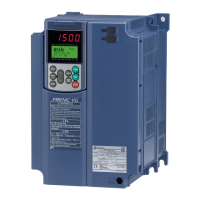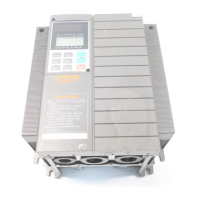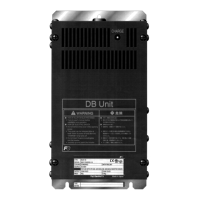5.3 Description of Function Codes
5-81
FUNCTION CODES
Chap 5
■ Motor Sound (Tone) (F27)
F27 changes the motor running sound tone (only for motors under V/f control). This setting is effective when the
carrier frequency specified by function code F26 is 7 kHz or lower. Changing the tone level may reduce the high
and harsh running noise from the motor.
If the tone level is set too high, the output current may become unstable, or mechanical vibration and
noise may increase. Also, this function code may not be very effective for certain types of motor.
F27 data Function
0 Disable (Level 0)
1 Enable (Level 1)
2 Enable (Level 2)
3 Enable (Level 3)
Terminal [FM], [FM2] (Mode selection, Output gain, Function selection, Pulse rate)
These function codes allow outputting monitor data such as output frequency and output current to terminals [FM],
[FM2] as analog DC voltage, current, and pulse ([FM] only). In addition, voltage and current output level on
terminals [FM], [FM2] is adjustable.
When switching voltage, current, and pulse, it is necessary to switch both mode selection function code
and switch on the PCB.
Terminal [FM2] is mounted only on
GB specification and C specification (for China).
There is no pulse output function for terminal [FM2]
Terminal Mode selection function Gain Function Pulse rate Switch
[FM] F29 F30 F31 F33 SW5
[FM2] F32 F34 F35 None SW7
■ Mode selection (F29, F32)
F29 and F32 select output form of terminals [FM], [FM2]. Accordingly ,change the switches SW5, SW7 on the
control PCB.
For details of the switches on the control PCB, refer to Chapter 12 “SPECIFICATIONS.”
F29 data Terminal [FM] output form Control PCB switch (SW5)
0 Voltage output (0 to +10 VDC) FMV side
1 Current output (4 to 20 mA DC)
FMI side
2 Current output (0 to 20mA DC)
3 Pulse output FMP side
F32 data Terminal [FM2] Output form Control PCB switch (SW7)
0 Voltage output (0 to +10 VDC) FMV side
1 Current output (4 to 20 mA DC)
FMI side
2 Current output (0 to 20mA DC)
The output current is not isolated from analog input, and does not have an isolated power supp ly.
Therefore, if an electrical potential relationship between the inverter and peripheral equipment has been
established, e.g., by connecting an analog
, cascade connection of a current output device is not
available.
Keep the optimum connection wire len

